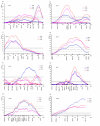Genome-wide QTL mapping for three traits related to teat number in a White Duroc x Erhualian pig resource population
- PMID: 19226448
- PMCID: PMC2672953
- DOI: 10.1186/1471-2156-10-6
Genome-wide QTL mapping for three traits related to teat number in a White Duroc x Erhualian pig resource population
Abstract
Background: Teat number is an important fertility trait for pig production, reflecting the mothering ability of sows. It is also a discrete and often canalized trait presenting bilateral symmetry with minor differences between the two sides, providing a potential power to evaluate fluctuating asymmetry and developmental instability. The knowledge of its genetic control is still limited. In this study, a genome-wide scan was performed with 183 microsatellites covering the pig genome to identify quantitative trait loci (QTL) for three traits related to teat number including the total teat number (TTN), the teat number at the left (LTN) and right (RTN) sides in a large scale White Duroc x Erhualian resource population.
Results: A sex-average linkage map with a total length of 2350.3 cM and an average marker interval of 12.84 cM was constructed. Eleven genome-wide significant QTL for TTN were detected on 8 autosomes including pig chromosomes (SSC) 1, 3, 4, 5, 6, 7, 8 and 12. Six suggestive QTL for this trait were detected on SSC6, 9, 13, 14 and 16. Eight chromosomal regions each on SSC1, 3, 4, 5, 6, 7, 8 and 12 showed significant associations with LTN. These regions were also evidenced as significant QTL for RTN except for those on SSC6 and SSC8. The most significant QTL for the 3 traits were all located on SSC7. Erhualian alleles at most of the identified QTL had positive additive effects except for three QTL on SSC1 and SSC7, at which White Duroc alleles increased teat numbers. On SSC1, 6, 9, 13 and 16, significant dominance effects were observed on TTN, and predominant imprinting effect on TTN was only detected on SSC12.
Conclusion: The results not only confirmed the QTL regions from previous experiments, but also identified five new QTL for the total teat number in swine. Minor differences between the QTL regions responsible for LTN and RTN were validated. Further fine mapping should be focused on consistently identified regions with small confidence intervals, such as those on SSC1, SSC7 and SSC12.
Figures

References
-
- Hirooka H, de Koning DJ, Harlizius B, van Arendonk JA, Rattink AP, Groenen MA, Brascamp EW, Bovenhuis H. A whole-genome scan for quantitative trait loci affecting teat number in pigs. J Anim Sci. 2001;79:2320–2326. - PubMed
-
- Borchers N, Reinsch N, Kalm E. Teat number, hairiness and set of ears in a Pietrain cross: variation and effects on performance traits. Arch Tierz. 2002. pp. 465–480.
-
- Pumfrey RA, Johnson RK, Cunningham PJ, Zimmerman DR. Inheritance of teat number and its relationship to maternal traits in swine. J Anim Sci. 1980;50:1057–1060. - PubMed
-
- Drickamer LC, Rosenthal TL, Arthur RD. Factors affecting the number of teats in pigs. J Reprod Fertil. 1999;115:97–100. - PubMed
Publication types
MeSH terms
Substances
Grants and funding
LinkOut - more resources
Full Text Sources
Other Literature Sources

